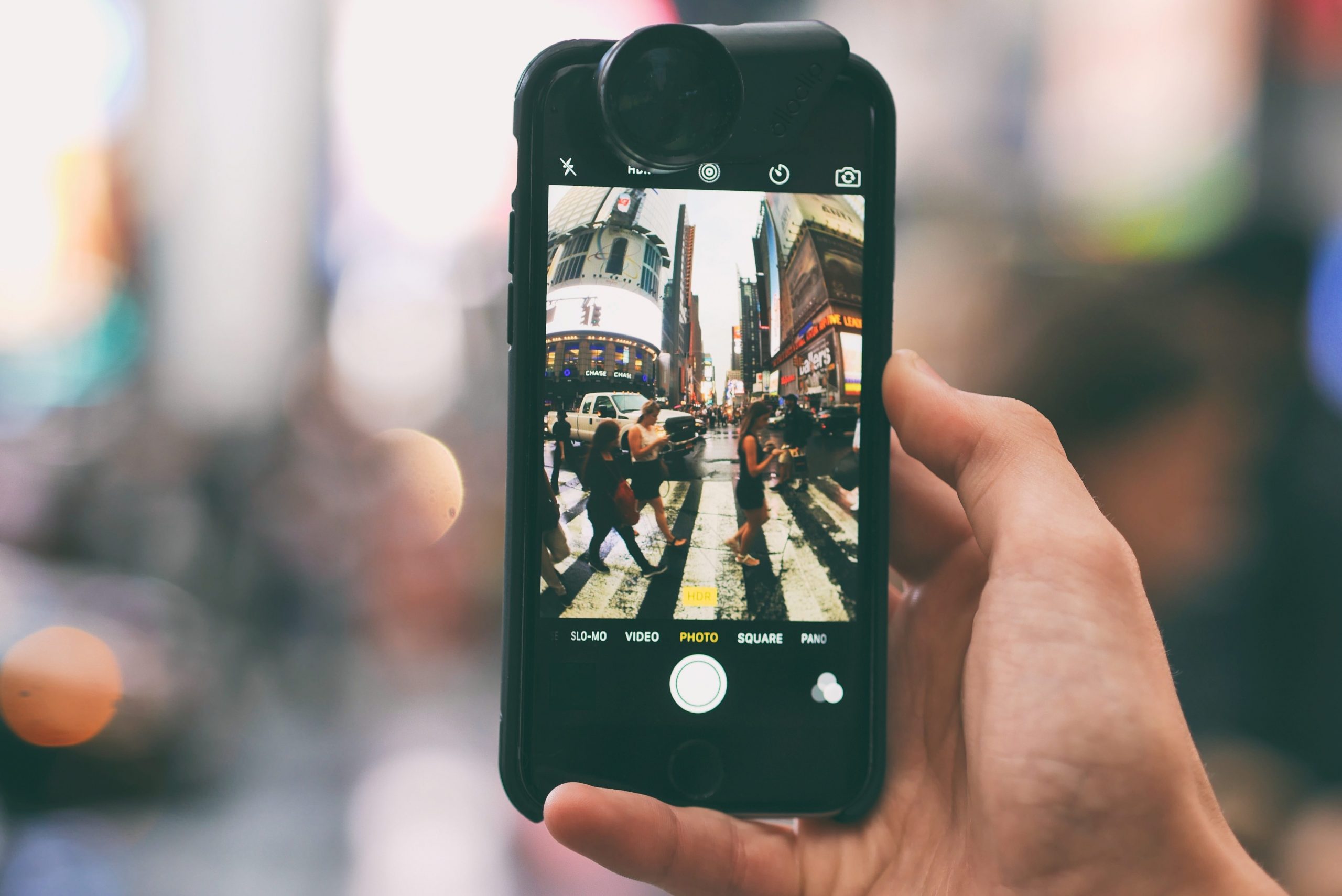
Walking on the Wild Side: Distracted Pedestrians and Traffic Safety
Vision Zero requires increased attention to the safety and behavior of all road users
Every time a driver is distracted, including by their cellphone, the risk of a traffic crash increases. And almost every driver owns a cellphone — 95 percent of American adults owned one in 2016, with 77 percent owning a smartphone. An analysis of 33 studies showed that cellphone use slows mean reaction time by 0.25 seconds, enough time to make a distracted driver extremely dangerous for others on the road.
But do cellphones make walking more dangerous as well? Distracted drivers clearly endanger pedestrians, but the impact of distracted pedestrians on traffic safety has not been extensively studied. A recent report from the National Highway Traffic Safety Administration concluded that “a very limited number of studies have investigated the effect of electronic device use by pedestrians” and that “there is a need to conduct naturalistic observations of the effect of electronic device use on pedestrian distraction and safety.” The issue is in the public eye, after cities including Honolulu, Rexburg, Idaho, and Montclair, California, passed legislation to fine any pedestrian using their cellphones when crossing the street.
Distracted walking could cause people to walk outside the crosswalk, against the pedestrian signal, or in other ways that decrease safety. Drivers may not expect to see pedestrians outside of a crosswalk as they turn, leading to more collisions with pedestrians violating the signal. If a distraction makes people walk slower, their decreased speed may mean people are still in the crosswalk while drivers attempt riskier turning maneuvers to get through the intersection as the light changes.
In order to minimize risk and design infrastructure that is safe for everyone, practitioners must know as much as possible about the behavior of pedestrians and drivers. If they don’t know who is distracted while walking (or driving for that matter), they cannot target educational, enforcement, or design strategies at the people most at risk for these types of behavior. We investigated elements of pedestrian behavior at signalized intersections through an observational field study, focused on the person- and site-specific factors associated with pedestrian distraction, violations, and walking speeds.
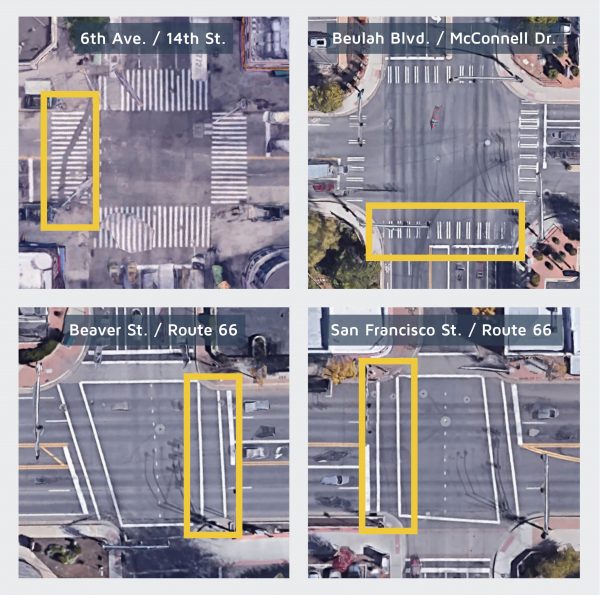
Study methods
We obtained our data at one signalized intersection in New York City and three signalized intersections in Flagstaff, Arizona (see right). Pedestrians were observed using high-definition field-mounted video cameras during the spring and summer of 2017. We sorted each of the 3,038 pedestrians observed across all four study sites into one of five distraction categories: no distraction, talking on cellphone, texting on cellphone, listening to headphones, or other (distractions not involving a cellphone, such as reading a newspaper or looking in a purse). We also noted several other factors for each pedestrian:
-
- Gender and estimated age
- Total number of fellow crossing pedestrians
- Average walking speed in feet per second, calculated by the time at the start and end of crossing combined with crosswalk length
- Signal indication at the start and end of crossing (“Walk,” flashing “Don’t Walk,” or “Don’t Walk”)
- Whether they stepped outside of the marked crosswalk during their crossing
- Whether they were crossing with or against adjacent roadway traffic
Table 1. Summary of study site characteristics
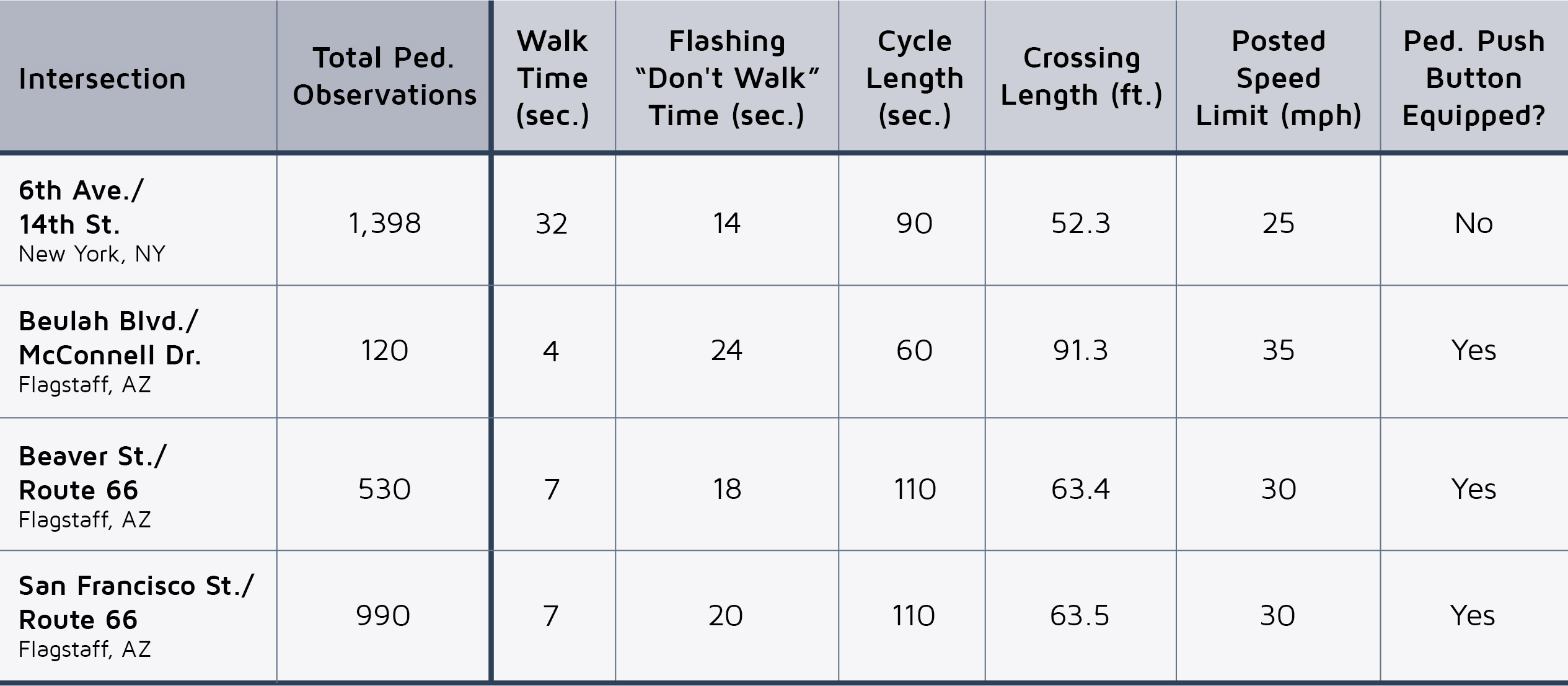
Who’s distracted?
Most pedestrians are not distracted as they cross the street. Overall, we observed just 14 percent of pedestrians talking, texting, wearing headphones, or otherwise using their phones as they crossed.
The demographics of distraction are varied. None of the age groups were statistically significant predictors of talking on a cell phone, but men were significantly less likely than women to talk on the phone while walking. Additionally, pedestrians who crossed alone and those who crossed outside of the crosswalk were more likely to be talking on the phone. People aged 16 to 29 and people walking alone were the likeliest to be observed texting while walking. Headphone use was most common among people aged 16 to 29, men, solitary walkers, those who had to wait for a walk signal, and those who walked faster than four-and-a-half feet per second.
Figure 1. Observed pedestrians by distraction type
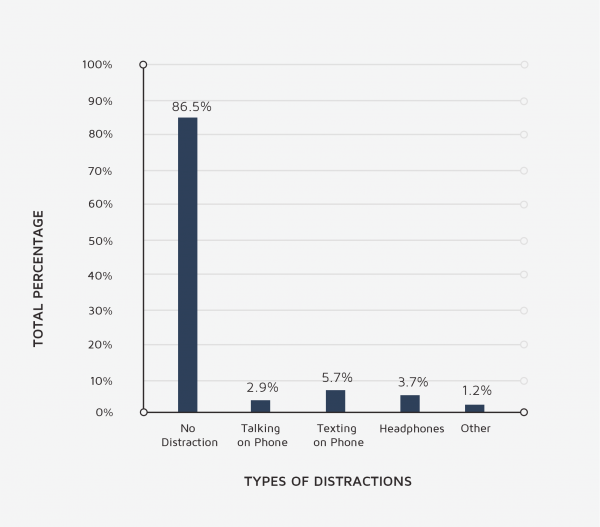
Who’s slowing down?
Among the number of pedestrians we deemed as distracted, we found that talking or texting did not cause a statistically significant impact on walking speed. While a previous observational study did find that phone use tended to slow pedestrians down, cellphone and especially smartphone use has increased substantially since then. Pedestrians may now be more accustomed to walking with their phones and better able to talk or text while maintaining their usual pace.
Walking speeds differed based on the type of distraction and the person’s individual characteristics. People using headphones tended to cross faster than “undistracted” walkers, and pedestrians in the “other” distraction category tended to walk slower, a result that is consistent with past research. As expected, pedestrians estimated to be 60 or older exhibited the slowest walking speeds, while those estimated to be in the 16-to-29 age range exhibited the fastest. Men tended to walk slightly faster than women, regardless of distraction.
Site-specific factors appear to influence walking speeds rather than phone use. The fewer pedestrians, the faster the crossing — those crossing alone or with one other person walked faster than those crossing in groups of three or more. This suggests that intersections where large numbers of pedestrians cross during each cycle experience overall slower walking speeds.
Furthermore, pedestrians crossing in the same direction as adjacent roadway traffic exhibited slower walking speeds than those crossing against. This may be the result of caution toward potential vehicles turning from behind, outside of their immediate field of view. And people who committed crosswalk violations also walked faster than those who crossed correctly. Pedestrians beginning to cross as the signal flashed or displayed “Don’t Walk” exhibited significantly higher speeds than those who started to cross during the walk signal, just as people who walked outside the crosswalk for at least a portion of the intersection also crossed more quickly.
Figure 2. Observed pedestrians by walking speed
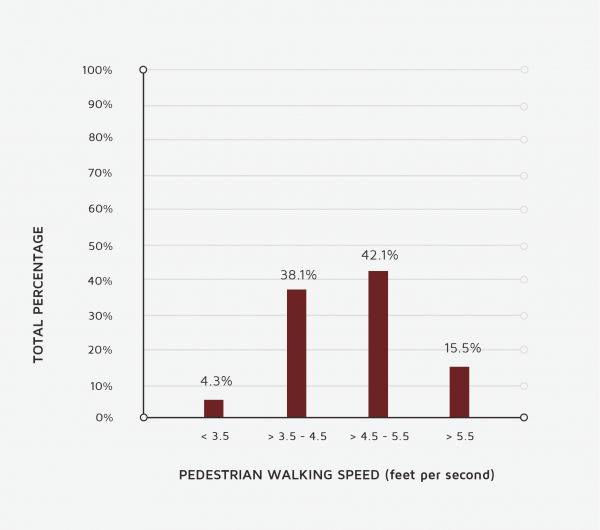
Who’s in violation?
Sixteen percent of the observed pedestrians committed a violation by crossing outside the marked crosswalk, while about 23 percent crossed against the signal (i.e. started crossing during “Don’t Walk” or flashing “Don’t Walk” pedestrian signal indications). Aside from male pedestrians being more likely to commit a crosswalk violation, none of the other demographic variables were statistically significant in predicting pedestrian violation behavior.
Pedestrians in groups of five or more were more likely to commit a signal violation, indicating this behavior may be deemed more acceptable when done with a group. Pedestrians in groups of three or more were more likely to walk outside the crosswalk, which may be a result of crowding in the crosswalk when larger groups are crossing.
Pedestrians who were texting while walking were more likely to cross outside the crosswalk, likely because their vision is focused on the phone and not the street markings. Slower pedestrians — those walking less than three-and-a-half feet per second — were more likely to stay inside the crosswalk.
Figure 3. Observed pedestrians by crosswalk position
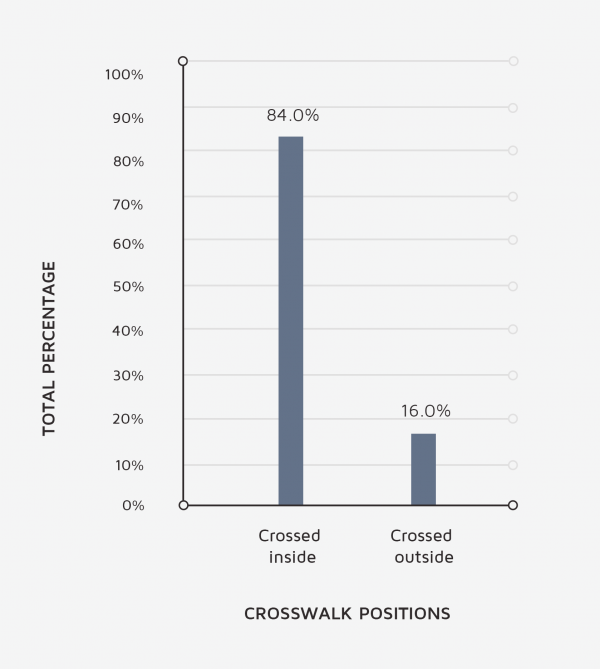
Conclusion
Crosswalks are shared spaces used by both pedestrians and vehicles, and are inherently designed to be conflict zones: There is no red light to stop every driver from entering every crosswalk when there is a pedestrian in it. Even when “walk” signals are activated, there are typically vehicles turning from multiple directions that can legally enter that shared space. A safe outcome depends on all parties being attentive to their situation.
Our findings offer some direction for improving crosswalk safety through policy and planning strategies. Because talking and texting while walking are not statistically significantly associated with walking speed, engineers may not need to redesign pedestrian signal timing in order to accommodate distracted pedestrians as cell phone and smartphone use continues to increase. Instead, policymakers may look to engineering solutions such as restricting drivers from turning right on red lights at locations that more prone to pedestrian distraction. Educational or enforcement campaigns aimed at certain demographics, such as the 16-to-29 age range, could promote attentive walking among the people more likely to be distracted.
Pedestrian distraction, even by 14 percent of people crossing at an intersection, presents a public safety problem — especially because pedestrians must stay alert due to the dangers posed by distracted drivers. Given the increased attention to safety campaigns aimed at eliminating all traffic-related fatalities, such as Vision Zero in cities around the country, policymakers should consider and address the behavior of all road users, including pedestrians crossing the street legally at signalized intersections.
